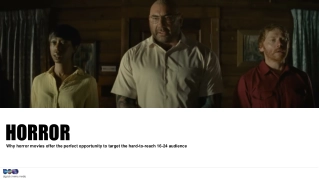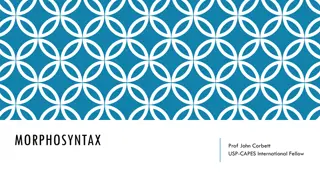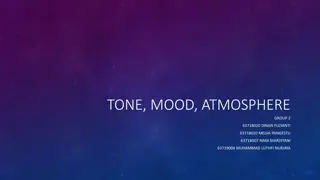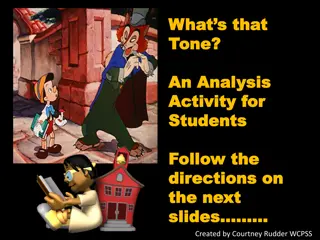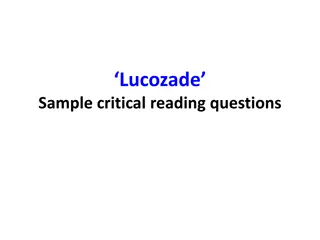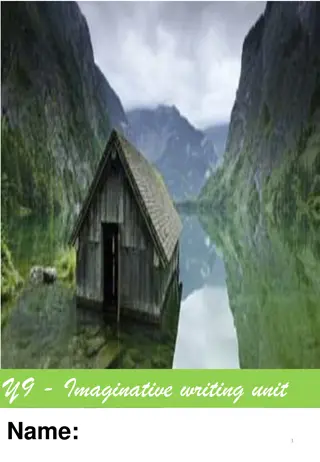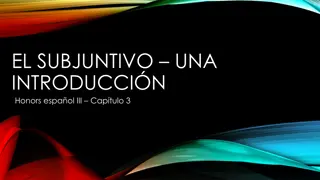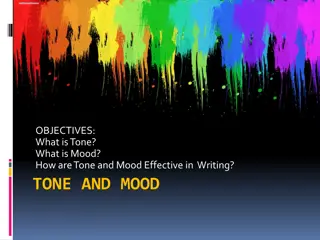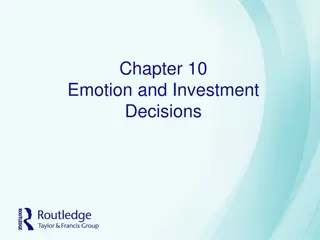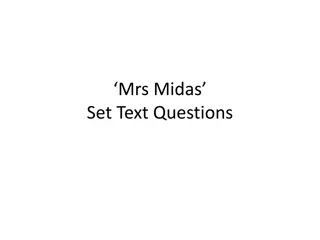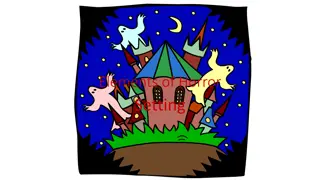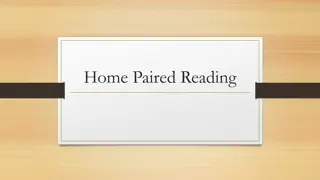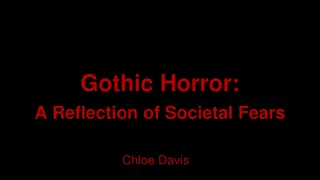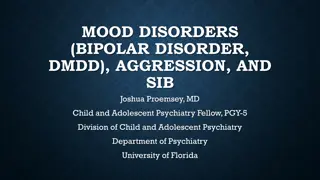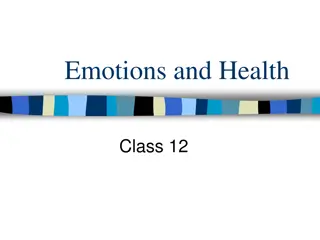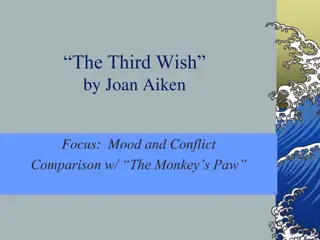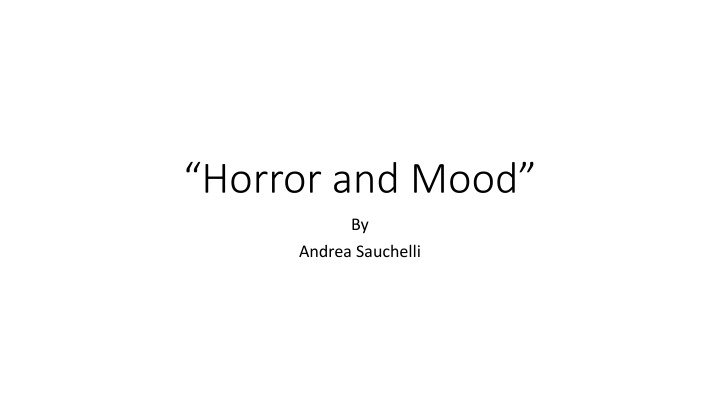
Horror Artworks and Mood in Various Mediums
Explore the distinctive elements of horror artworks in film, music, poetry, painting, sculpture, and literary fiction as discussed by Andrea Sauchelli. Discover the different accounts of horror, the distinction between emotion and mood, and the capacity of horror works to evoke specific moods. Delve into the concepts of art-horror versus natural horror and objections to traditional theories of horror in art.
Download Presentation

Please find below an Image/Link to download the presentation.
The content on the website is provided AS IS for your information and personal use only. It may not be sold, licensed, or shared on other websites without obtaining consent from the author. If you encounter any issues during the download, it is possible that the publisher has removed the file from their server.
You are allowed to download the files provided on this website for personal or commercial use, subject to the condition that they are used lawfully. All files are the property of their respective owners.
The content on the website is provided AS IS for your information and personal use only. It may not be sold, licensed, or shared on other websites without obtaining consent from the author.
E N D
Presentation Transcript
Horror and Mood By Andrea Sauchelli
Introduction Introduction Sauchelli s question: What is distinctive and essential to horror artworks? Artworks to consider: Film, Music, Poetry, Painting, Sculpture, Literary Fiction His main answer: These artworks share a variable set of rhetorical devices designed to elicit a specific mood. [p40LeftTop]
Sauchelli (AS)s Objectives in Horror and Mood 1. Discuss a competing account of Horror (No l Carroll s), a) outline objections to that account, and b) offer an alternative account that covers artworks that are not handled well by Carroll s. 2. Explain and defend a distinction between emotion (as defined by Carroll) and mood (the main alternative element in AS s account of horror) 3. Give an account of art-horror in terms of the capacity of works of horror to elicit a specific mood and a specific attention toward generally unpleasant issues. [p40Lm]
I. Art Horror and Monsters I. Art Horror and Monsters Art-horror vs. Natural-horror: Art-Horror = cross-media genre/style in the category of art. Natural-Horror = horrific real events or situations that do not fall into the category of art-horror. Examples of Art-Horror: Shockumentaries (Faces of Death, Traces of Death) These include real footage of gruesome deaths, but the actual event recorded in such footage constitutes Natural-Horror. Question for class: what explains the difference between real footage of events that were in themselves Natural-Horror, and the status of Faces of Death?
Carroll (NC)s Theory (For us, this is Review) For NC, art horror = artworks that evoke emotional reaction[s] [fear and disgust] an audience is supposed to have when exposed to unnatural monsters. [p40Lb] Unnatural Monsters = a) the actual existence of the monster is not supported by science; b) disgust/fear reactions to the monster are due to their impurity (where impurity = the creature s violation of various natural features of the real world) Example: zombies (because the dead do not walk the earth ) Emotional reactions = bodily agitations and modifications that are directed at objects and are individuated and distinguished by a correlated cognitive component. Emotional reactions associated with horror (fear/disgust) are only distinguished from non- horror reactions (love/joy) by beliefs associated with the cause of the bodily agitation/modifications (loved objects are attractive, feared/disgusting objects are threatening/impure)
Objections to NCs Theory A. Films like A Serbian Film (2010) .in which there are scenes of explicit sex and decapitation, but none of the characters are supernatural . B. Multiple examples of films that lack monsters but are regarded by viewers as horror films: Shockumentaries like Traces of Death, or art films like Tarkovski s Stalker. C. Paintings like Francis Bacon s, music from death metal bands like Carcass, Cannibal Corpse, Mayhem (music is especially resistant to NC s theory because music is not representational and hence cannot actually include a monster the way a film or literary fiction can). What Saves NC s Theory It covers a subset of Art-Horror films very well (Alien, The Fly, The Thing, The Host).
II. Moods (ASs alternative account of Horror) II. Moods (AS s alternative account of Horror) Moods vs. Emotional States Moods vs. Emotional States Some Examples Some Examples Moods Emotional States Hate, fear, anger Love Depression, elation, anxiety Feeling content Differentiating Features Not object-oriented Longer-lasting background states Preparatory states orienting us toward a particular emotion Object-oriented Hate, fear, anger Foreground states
Moods vs. Emotional States (contd) AS thinks that the preparatory function of mood states captures an important contribution of moods generated by Art-Horror: to set the affective background of the spectator for what is to follow. [p42Rt] The background affective state includes fear and/or disgust, but it also creates an atmosphere of tension. Pylyshyn & Sizer: moods not only prepare us for certain emotions, they change how we characterize things (JP: so a mood can set in motion a cognitive change reflected in resulting expectations/interpretations of events. [p42Rm/b]
III. Horror and H III. Horror and H- -mood mood AS s Theory of Art-Horror: Work w is an instance of Art-Horror iff. w is designed to evoke a specific H-mood using the artistic means peculiar to the form of art to which w belongs. H-mood = [a mood] evoked in representational arts by a morbid attention toward (principally) death, murder, and evil [p43Lt/m]) According to AS, how do Art-Horror Films generate H-moods? Answer: primarily through mise-en-sc ne(= the setting or surroundings of an even or action ) AS thinks this is crucial since this generates so much of the tone of a film, and obviously tone directly generates mood insofar as mood is as much affective atmosphere as anything else.
Examples in Film: Alien: a suffocating atmosphere (humans trapped in closed space with walls and ceiling too close, much of which is dimly or completely unlit). Dawn of the Dead: the music Profondo Rosso contributes to an atmosphere of dread. Psycho: the music in the shower scene (the piercing violins in rhythm with the slashing knife) AS s best reason for preferring mood over emotion in accounting for Art-Horror: the details that generate a certain atmosphere, rather than the metaphysical features of the protagonists or monsters, are the elements that enable us to characterize a work of art as an example of horror. To consider: Hitchcock s Vertigo in which various features of the way the story line unfolds generate atmosphere (JP: There s no monster either!)
AS thinks that because mood is mainly determined by features of an artform that generate atmospheric effects, Art-Horror is more like a style than a genre (where genre involves content-related features that must be present for the kind of artwork involved to fall in its particular category). Is AS right? Consider other film genres (thriller, romance, drama, heist, comedy, western, action) and ask: do these, or don t these, involve atmospheric effects? If they do, then are they also styles as well as genres? AS s Account of H-Mood H-mood is characterized by a feeling of tension related to a morbid inclination of our attention toward a set of unpleasant aspects of reality that, in the case of horror, include mostly death, murder, and evil forces. This account requires a clear distinction between expressing a mood or emotion and evoking a mood or emotion. The difference seems to be that a element of an artwork that expresses an emotion or mood just represents that emotion or mood.
AS on the Paradox of Horror: What is the paradox here? AS: The issues (death, monsters, threatening supernatural events, murder, evil entities, etc.) that are aroused in the cognitive side of horror are associated with experiences that, at first approximation we have good reasons to avoid. Given that fact, why would we choose to experience them, and even be drawn to them? It seems to be a psychological conundrum (much like the practices of S&M). Discuss.
Criticisms of ASs Account of Art-Horror It includes things that wouldn t be Art-Horror. AS s Defense: yes, but that is part of his point: my account is intentionally broad to include the possibility of recognizing many different subgenres: horror/thrillers, slasher movies, violent exploitation films, and possibly also works of religious art. [p45Rt] what my theory is meant to emphasize is the possibility of recognizing a family resemblance among samples of art-horror, thereby providing criteria for the artistic success of those works that can be properly classified as horror. [p46Lt]
Reasons to Value Art-Horror AS gives 5 explanations that account for and assert the value of Art-Horror. #1: Allows us to experience affective states that we would be fortunate to never experience in real life is valuable in itself. #2: Encountering representations of fearful things (like death) that are beyond our control is valuable since it helps us cope with and address those fears. #3: There is aesthetic pleasure in experiencing the way that an artwork conveys situations of pain and despair, a world of suffering, etc. (e.g.: David Lynch s masterful evocation of a waking nightmare in Mulholland Drive is beautifully put together [cinematography, acting, etc.])
Reasons to Value Art-Horror (contd) #4: Painful art contributes to disconnecting the classic association between pleasure and beauty (where some have objected that this does not mean that art that evokes pain is ugly, but rather that experience of artworks that evoke pain are not opposite those that evoke pleasure, but are parts of a dense and complex phenomenon [one sign of which is that evoked pain and fear are experience intensifiers]). #5: Painful art is faithful to our real human condition (and therefore respond to that human interest in artistic representations of actual human experience, including painful and fearsome ones).
Why Horror? By No l Carroll
Carroll beings with a question: Why would anyone wantto be art-horrified? NC s view has been that repulsion or disgust are the key emotional elements of art- horror. How can what is repulsive or disgusting be pleasurable? This is the Paradox of Horror
Carrolls Account of Art-Horror (redux) Art-Horror turns on the presence of a monster. The associated narrative style revolves around proving, disclosing, discovering, and confirming the existence of something that is impossible, something that defies standing conceptual schemes. This makes the audience curious about the monster: what kind of thing is it? What can it do? Monsters are the perfect behicle for curiosity since they are impossible beings. Their expectations revolve are what amounts to a narrative secret : Horror stories are often protracted series of discoveries. [p35t] Upshot: Art-Horror that works with monster/monsters is, then, a species of mystery narrative. But in this case, the question is not Who done it? but Does the monster exist, and if so, Whatis it? Question: But are all horror films built around curiosity about a monsters?
Carrolls key claim: The pleasure in Art-Horror is cognitive: we enjoy trying to figure out whether the monster exists, then if it exists, how it exists, how it can be fit into our existing cultural/conceptual scheme, etc. NC thinks that the driver of disgust and fear is that the monster violates our classificatory scheme . NC adds that to function as the locus/stimulant for the pleasurable pursuit of our natural curiosity about an impossible being, they must add features that make them objects of disgust, loathing, disturbing and repulsive. JP: NC s point seems to be that without our repulsion, disgust, loathing and fear tied to these rejecting emotions, we would not be so caught up pleasurably in the complex cognitive process of discovery and disclosure.
Objections to Carrolls Account 1. Other genres (notably, detective stories, disaster narratives, dystopian climate change sagas, etc.) involve the same process of discovery, confirmation and associated cognitive tools of exploration/disclosure. Some Art-Horror lacks any narrative at all (horror paintings) and some lack the discovery/confirmation elements of exploration & disclosure. [pg38t/m] The emphasis on the puzzle about the apparently impossible and consequent interest in discovery/exploration/disclosure processes doesn t seem to connect all that to the emotional of revulsion that is the central quality that distinguishes the genre. [pg38m] 2. 3.
NCs Replies to Objections to His Account Reply to No. 1: Yes, but these others don t involve an evil that is impossible [or,] in principle, unknown nor one that inspires disgust or loathing. NC s Reply to No. 2 and No. 3: these objections are good ones and show that the account/ conjecture needs to be expanded to cover these. NC s Solution: curiosity is not only aroused by the impossibility of the Beast, but the objects of Art-Horror in and of themselves engender curiosity as well. [pg38b] Key to the Solution: that the impossible Beast is IMPURE/anomalous. Anomalies are interesting elicit interest . Upshot: what is disturbing, distressing, disgusting is also riveting/thrilling. [pg39m]
NOTE: NC mentions the thought theory of fictional emotion that he covers earlier in his book. This takes it that the audience knows that the Beast does not exist. They are merely reacting to the possibility that such a being MIGHT exist (and this comports well with Gaut s account of fictional emotion in terms of making-believe). This gives NC a solution to the first objection to the conjecture : non- narrative Art-Horror evokes curiosity precisely because they promote fascination at the same time they distress since even without a narrative approach to the Beast, the presentation nonetheless gets us imagining that such a Beast could exist (The Unseen Monster Under the Bed can be replaced by a painting of a child looking under a bed with a terrified look on their face).

